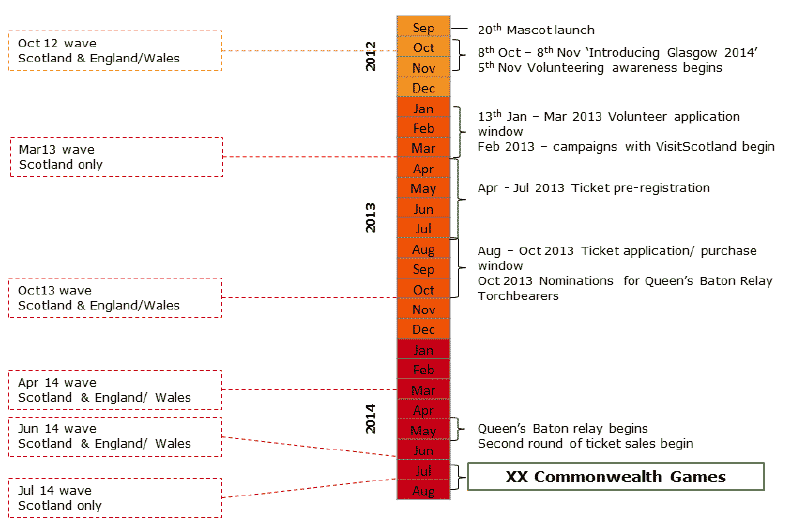XX Commonwealth Games Omnibus Research Report
This XX Commonwealth Games Omnibus Research Report measure progress against key marketing performance indicators (KPIs) and generates new insights that supported decision making around marketing activity in the run up to Glasgow 2014.
2. Survey Background and Approach
Survey background
2.1 Between the 23rd July and 3rd August 2014, Glasgow[3] hosted the XX Commonwealth Games, a defining event for the city and for Scotland as a whole.
2.2 Events covering 17 different sports took place over an eleven day period, in addition to opening and closing ceremonies and a range of associated cultural events and programmes.
2.3 The G2014 Organising Committee's (OC) remit was to make the 2014 Commonwealth Games a success for Glasgow and Scotland by:
- Generating high levels of engagement and attendance, with Games' venues full of fervent supporters;
- Enlisting an army of committed volunteers, eager to be part of the Games and make them an event to remember;
- Building significant community engagement through events such as the Queen's Baton Relay;
- Delivering Games that will have a lasting impact on the nation beyond 2014.
2.4 In 2012, the Commonwealth Games OC and the Scottish Government appointed TNS to undertake a quantitative research programme. The objective of this research was to measure progress against key marketing KPIs, and to generate new insights that would support decision making around marketing activity in the run up to Glasgow2014.
Survey approach
2.5 This report summarises the main results generated from the inclusion of questions on six separate waves of the TNS Scottish Opinion Survey (SOS) and four separate waves of the TNS GB Omnibus Survey.
2.6 The SOS is a monthly in-home face-to-face Omnibus survey undertaken with a nationally representative sample of adults living in Scotland aged 16 and over. The target sample size is c.1,000 respondents per wave.
2.7 The GB Omnibus survey provides a representative sample of adults aged 16 and over living in England and Wales and also uses an in-home face-to-face approach. For this survey, the target sample per wave was c.800.
2.8 As shown in Figure 2.1, survey waves were scheduled in order to provide timely information around key milestones in the run up to and during the Games.
Figure 2.1. Timing of research waves and key Games milestones

2.9 The key objectives for the research were to:
- Measure and track progress against key metrics including awareness of the Games, recall of promotional activity, interest in and behaviour in relation to the Games.
- Generate sufficient responses to allow for analysis below the population level.
2.10 This report presents data collected during all waves of the research programme. Topic areas covered by the research included:
- Awareness and knowledge of the Games;
- Levels of support and supportive actions;
- Ticket purchase interest and action;
- Recall of promotional activity.
2.11 Further details on the questions featured in each wave, can be found in Appendix 2 (Technical Appendix). Full data tables are available separately.
Contact
Email: Imelda Giarchi
There is a problem
Thanks for your feedback